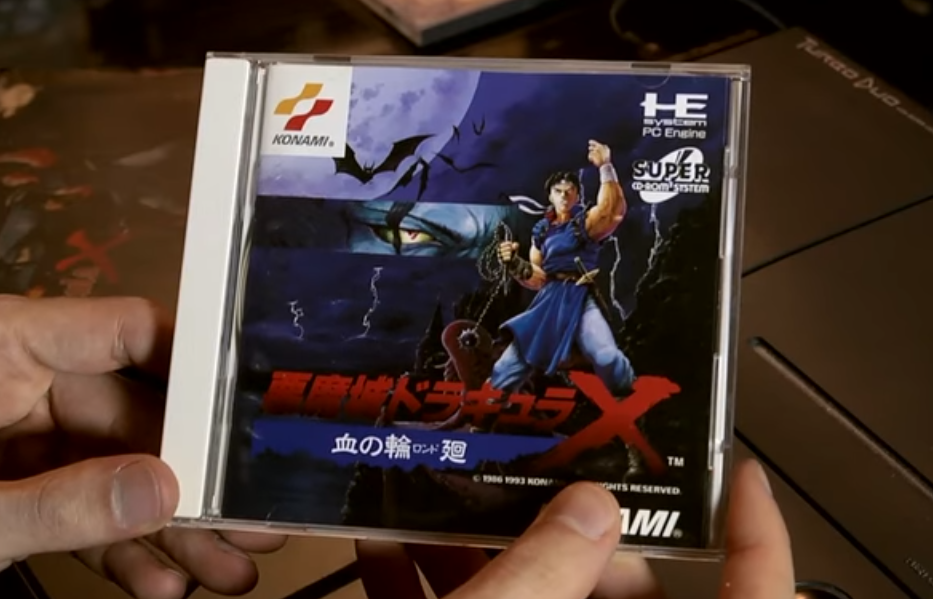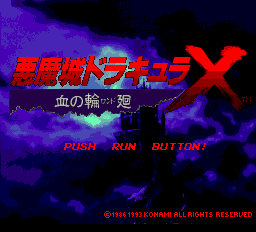Dracula is a menace once again and a vampire killer from the Belmont clan storms his way through Castlevania to stop him in a classic 2d action platformer that never got a US release. The game is pretty rare, and I’m lucky enough to own a copy, so I wanted to talk with you guys about it.
This game is often claimed to be the best Castlevania game. At this point, I think it definitely could be. I don’t want to call it yet because I still have more games in the franchise I need to play first, but I can say at this point in time that it has to be one of the best, for sure. One day I will be able to rank all these games in order, and I’m very sure Rondo of Blood will be either close to the top or the best. It’s an incredibly good game.
This is perfectly playable for people who don’t speak Japanese, with the exception of a couple unskippable cutscenes. All menus and indicators are in English. There’s no region locking on TurboGrafx-CD games, so people outside of Japan shouldn’t have difficulty getting this to run. If you want to play the game in English, you’ll have to play Castlevania: The Dracula X Chronicles for PSP and unlock Rondo of Blood within that game.
This article will be an analysis of what makes this game so great. I’ll try to be as light on the spoilers as I can, because you really should go into this game blind and be surprised by what it has to offer. Castlevania: Rondo of Blood gets so many things right that few games do, and I think there’s a lot this game can teach us about masterful game design.
Design Balance
Games very often have dominant strategies that take precedence over most or all of the others. For example, as great as Contra is, it’s really disappointing how powerful Spread Shot is compared to everything else. The game would be a lot better and more fun if every powerup was useful. It really sucks having your fate decided for you because one way to play is clearly more optimal to the others. You’re stuck doing what works.
As most of you already know, Castlevania games have a powerup called a Subweapon, which is projectile attack you pick up that can be activated at the expense of Hearts. Many Castlevania games are designed in such a way that some Subweapons are nearly useless and some are incredibly powerful. This sucks because it locks you into one playstyle and it robs the game of strategy and variety.
Rondo of Blood doesn’t have this problem. Every Subweapon in this game is powerful in different ways, and they also have to be used in conjunction with Richter’s basic moves and the whip. Instead of picking a favorite and using it for the entire game, the game constantly demands that you swap Subweapons to fit your needs in the area you’re about to enter next. And while the whip is powerful, there are plenty of hazards in the game that require you to use a Subweapon instead. And these Subweapon choices aren’t cryptic, you can simply play an area without the Axe and you will think to yourself “man, the Axe would be really handy right about now” and remember that for next time.
Each subweapon will shine over the others in different parts of the game.
This kind of game balance can’t be achieved by simply adjusting all the weapon strengths in a game’s code. The entire game has to be designed around this concept from start to finish, and it has to be a high-priority goal in the game’s design process. If you were to look at all the enemies and levels in Rondo of Blood, you’d see a good spread where each Subweapon has areas it excels in and areas where it’s sub-optimal or even useless. This is fantastic game design, where the whole game and its individual parts are designed to complement each other.
I’ve seen a lot of games fail to do what Rondo of Blood does. Games with massive AAA budgets or games with very talented developers often fall victim to their games being ruined by this phenomenon of one single strategy taking over the entire game. And what results is boring, because you just do the same exact thing for the entire game and you’re not engaging with the game on a strategic or problem-solving level.
I believe if a game gives a player strategic options, every strategy should have a use somewhere, and no one strategy should too useful. Rondo of Blood proves how this philosophy results in a great game.
Strong Basic Toolset
If you plan on reading this blog in the future, you’re going to hear me talk about controls a lot. It’s probably one of the things I care about most when talking about video games. The good news is, Rondo of Blood’s controls are fantastic.
Richter Belmont, the main character of Rondo of Blood, is designed to have controls that strongly resemble the early classic Castlevania games, with a lot of very subtle improvements. Rondo of Blood doesn’t aim to reinvent classic Castlevania gameplay, it’s an attempt to perfect it.
The former stiffness of early Castlevania installments has been refined into tight controls that still offer challenge but give the player enough mobility to attack and defend comfortably. Richter has a couple new maneuvers, but it seems like these were added with very special care not to deviate too much from the classic feel.
When you double tap the jump button, Richter will execute a sweet backflip move. At first you might wonder when you’re ever going to use it, but there are so many opportunities for backflips in this game. Richter will fall right into a safe pocket of many enemy attack animations and often end up in an advantageous position on landing. It’s satisfying, useful, and it’s one of the game’s best features.
Learn to backflip like a pro and you will bring this game to heel.
The backflip can be cancelled into a whip strike.
There’s a couple other quality-of-life improvements as well. If you pick up a Subweapon, your previously held Subweapon will appear on the ground so you can get it again if you picked up the new one by mistake.
I could make a list of about 100 games that desperately need a feature like this.
You can also hold down the attack button to lock Richter facing in one direction regardless of which direction you walk, which makes aiming the whip and Subweapons much easier in certain situations.
You can freely crouch and stand during the whip animation, which can be useful.
Cash in your extra hearts acquired during the level on the Item Crash move to make boss fights easier.
A Healthy Dose of Randomness
Rondo of Blood strikes a nice balance between predictability and unpredictability. I don’t want to go into excruciating detail about this, but this game has a lot of controlled chaos in it that keeps the game from being a step by step procedure. Enemies can spawn in different areas and amounts, and bosses generally select from their set of attack patterns randomly. I really like how this game takes the middle ground between totally scripted events and complete randomness, and it’s a pretty smart approach to game design. You can learn this game in a general sense, but there’s still going to be things you encounter in every run that you have to react to in the moment.
Most bosses cycle randomly through a lot of different attack patterns, but they usually telegraph what they’re about to do next so you can react.
Branching Paths
I don’t want to make the claim that every game necessarily needs branching paths. It’s true that a lot of games with branching paths are enhanced and enjoy extra replayability because of it, but it’s not a requirement for a game to be good or to even have good replayability. I don’t even really think a game needs to necessarily be replayable to be good either, although lots of people have that preference and I respect that. For example, I loved playing Assassin’s Creed Origins. But that game took so long to beat, I don’t know that’d I’d ever put in the time to do it again. But I am sure as hell glad I experienced it once.
A game needs a good reason for branching paths in order to make the game better with it. Game development costs time and money, and development studios might not necessarily get a return on their investment by adding all these extra optional levels. I’ve definitely played games like this where I had no desire to play them again to see what I missed.
Castlevania: Rondo of Blood branches heavily, and with the wide variety of levels, enemies and bosses, individual playthroughs will be wildly different depending on the route taken. Castlevania III had this feature, but Rondo of Blood has a better idea of different routes being discovered within the levels via secrets rather than selecting a path via a menu screen. A couple of these secret paths can be cryptic, but for the most part, you’ll find them if you put in the effort to look for them.
Or you can just find a different path completely by accident.
The big justification for Rondo of Blood’s branching path system, besides giving the player fun rewards for exploration if they choose to play the game again, is the fact that this game is very difficult. The branching path system definitely alleviates the player getting stumped by a particular level or boss, because they can try a different path where they may fare better. That is where the branching path idea starts to really become a good feature.
I think the branching paths compliment this game because it’s the kind of game with very fairly designed challenge that rewards practice. It’s likely you’ll be interested in playing this game multiple times to get better at it, and the branching paths can make that experience more pleasurable. The hardest stage in the game is on one of these secret alternate paths, so there is something to strive for even after you’ve completed the game.
There are some pretty big secrets to find in this game, and one literally game-changing secret which I won’t spoil, so you definitely should be experimenting and poking around the levels to see what you find.
Impressive Presentation
Castlevania: Rondo of Blood has aged very well, and I think it will continue to. The only quirk is the sound effects, which are standard TurboGrafx-16 sound effects which play over the CD audio of the music track. I think there’s a certain charm to this clashing of sound quality, as it’s something that is very specific to its time and no other.
It’s a Castlevania game. Of course the music is good.
Just about every character sprite in this game has been reused in future Castlevania titles, with added frames to make the animation smoother. If another remake of Rondo of Blood was to be attempted, all of these upgraded sprites could be brought back into the game they were taken from and make for a truly spectacular experience. If those of you out there who make fan games are looking for your next project, consider that one. I would love to play Rondo of Blood with Richter’s smoother controls and animations from Symphony of the Night (without the additional overpowered abilities he got in that game, of course).
A Fair Challenge
This game is very tough, but it’s the kind of tough where you can learn for yourself how to get through. You don’t need a walkthrough for this game, and it’s more fun to go in completely blind. I like games that are self-contained in that way, and there are way too many games out there that necessitate some kind of guide to get through without suffering excessive amounts of frustration. If you know Richter’s moves and keep trying the levels, you can get through this game. There’s only one part of this game I consider to be unfair, which is a desperation move from the boss of stage 6 that can kill you even after you’ve won the fight, but I thought everything else was solid.
You will definitely have plenty of moments like this playing Rondo of Blood.
Conclusion
I find it strange this game didn’t get a US release. I think it would have been a big seller on the Playstation 1 because of the commercial success of Castlevania: Symphony of the Night and the general popularity of the Castlevania franchise in the US. American audiences were definitely ready for this game, and it never came.
There was a SNES adaptation which ended up being a very different game, and a PSP remake which came years later. Each of those versions require their own review, so I’ll be talking about them later.
Unless you truly dislike difficult games or 2d action platformers, I think this is definitely a game you need to play someday. Every Castlevania fan should play it, for sure.




Great Post as always!
Pls review or do playthrough of the psp one
Theres a game i would like to see you play. Its very challenging and puzzlling. Its called Solstice for NES. Please check it out.
Loved the review, Mike. Want to give this game a try.
If you like the classic Castlevania games you def should!
As an expert video gamer myself, I am surprised I never heard about this game, I may have to see if there is an emulator and give it a shot. Great article.
LOL !
You make my day !
Can I play too ?
« As an expert NBA players myself, I’m surprised I never heard about Shaquille O’Neal » 🙂
I played the game using a PC Engine emulator. works rly well
Does this game have a time limit? It’s good to explore without it…
This is my first visit to this site and I got to say, it was worth it! Excellent review and I definitely would consider playing this game wherever it’s available. I don’t have a PSP or turbografx-16 so hopefully they make some kind of PC version or something or there is some release on PC even if it’s unauthorized.
Very nice Mike. I enjoy your stuff solo and the stuff you do with James as well but I gots tell you you’re a hell of a writer. I think it’s a good mark if you’re reading something and it flows well enough to hear it in the writers voice, something I can definitely do with your writing.
I wanted to point out for anyone interested that this game is available on the original Wii for download. But you only have until March to add points to your account because Nintendo is getting ready to shut down the store.
“There was a SNES port which ended up being a very different game”
It’s not a port though.. That’s why it’s so different. A port shares source code. Castlevania: Dracula X is literally a different game that just uses some sprite assets (of which even those are slightly altered) used in Rondo of Blood.
Treating CVX and Rondo as the same entity is really unfair and not only that, it ignore the fact that we got not just 1, but *2* Richtervania titles which are arguably the pinnacle of Classicvania.
Beyond that, I think this article is great outside of Rondo being obscure (this game has had 3 US releases at this point…) and difficult (you beat CV3. You know this game isn’t hard). Regardless good read. Keep on keepin’.
The original TG-CD version is obscure, as not a whole lot of people have played it on the original hardware. And most people would find this game difficult. Someone like Mike being really good at games running around calling everything “easy” isn’t very helpful to the average reader.
I played a little of this on psp and it really is awesome.
Everything Mike said is on point.
I would of liked to have played more of it.
Definitely a must play in the series.
This game is a work of art.
This game’s been completely translated to English. There’s an ISO patch for it that will work on emulators and real hardware.
I simply couldn’t go away your site prior to suggesting that I extremely
loved the standard information a person supply to your guests?
Is gonna be again ceaselessly in order to inspect new
posts.
Appreciate this post. Let me try it out.